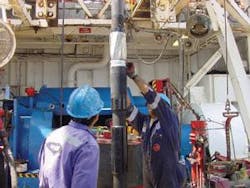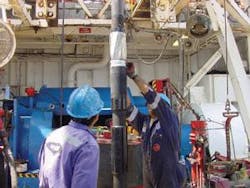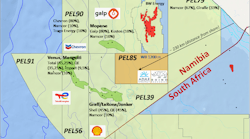BP PLC and Shell are developing and integrating new downhole technologies in their worldwide exploration and development projects.
BP’s in-house “Pushing Reservoir Limits” program is developing new methods to drain oil reservoirs more efficiently by decreasing conventional oil saturation and increasing reservoir sweep. PRL technology director Andrew Cockin says the program’s objective is to “provide several additional billion barrels of resources over 20 years.”1 BP and Nalco chemists developed a new polymer, “Bright Water,” that may improve water flood performance.
Last month at the company’s Woodcreek office in Houston, Shell’s global wells technology manager, Lance Cook, told industry media that “the easy oil and gas is gonenew technology is needed for a new age.” The company’s size and geographic spread, he said, allows it to develop certain technologies in-house and test in a variety of different conditions. Cook said the ability to implement globally helps to differentiate Shell from its peers.
Shell engineers are working to reduce costs by drilling smaller diameter wells and smaller logging tools. The company is testing expandable tubulars to increase the reach and through-bit logging tools to evaluate reservoirs. Cook said that maintaining the maximum hole size with expandable monodiameter tubulars should maximize potential production. The company is also using swellable elastomers for selective isolation within wellbores, a less expensive alternative to solid packers.
Expandable tubulars
The concept of expandable tubulars arose in the early 1990s and the Shell research center in Rijswijk developed variations on expandable slotted tubulars, expandable solid tubulars, and swellable elastomers.2
Shell Technology Ventures invests in step-change technologies. STV founded Enventure Global Technology in 1998; its primary technology is solid expandable tubulars. Enventure’s first monodiamter well was drilled in Starr County in South Texas. In 2002, natural gas producer Nederlandse Aardolie Maatschappij BV, Shell International Exploration and Production BV, and Enventure installed the world’s first corrosion-resistant alloy (13Cr) solid expandable tubular system in a well in the Netherlands.
Shell is now running expandable casing in the Gulf of Mexico, North Sea, Oman, and Southeast Asia. Through the end of 2006, Shell ran:
- 632 solid expandable jobs with Enventure SET.
- 448 expandable sand screens with Weatherford ESS.
- 24 Poroflex jpbs with Halliburton.
- 18 EXPress jobs with Baker Oil Tools ES system.
Shell projects accounted for 18% of the industry’s Enventure SET footage, according to Peter J. Sharpe, Shell wells vice-president and chief well engineer .
In 2007, BP completed a technology-collaboration agreement with Weatherford International Ltd. to develop its monobore solid expandable system. BP successfully tested four sizes of Weatherford MetalSkin open-hole liner system: 51⁄2-in. expanded to 7-in.; 75⁄8-in. expanded to 95⁄8-in.; and 113⁄4-in. to 133⁄8-in.
BP also supported a development program for expandable sand screens with Weatherford, Baker Hughes, and Schlumberger.3
New elastomers
Swellable elastomerselastic materials that swell in fluidsare used to create openhole zonal isolation systems. Their simplest form is a swellable rubber sleeve outside a casing joint. The synthetic rubber compounds swell when they come in contact with formation fluids.
Base rubber can be customized with additives to respond to immersion in either oil (solvent swelling) or water (immersion swelling). Oil-swelling elastomers have low swelling capability in heavy oil and at lower temperatures but higher swelling ability in light oil and higher temperatures. Water-swelling elastomers have low swelling capability in high-salinity water and low temperatures, and higher swelling ability in low-salinity water and higher temperatures.2
Elastomers can swell 600% (volume) and 100% (thickness), but “there is a tradeoff between swell ratio and pressure sealing capability,” according to Swellfix Chief Executive Officer John Dewar.2
Shell developed its swelling elastomer technology in its Wells research lab in the early 2000s.2 The company is using swellable elastomers instead of cement, solid packers, or external casing packers (inflated with cement) to isolate zones and to prevent fluid influx. Using swellable packers can eliminate extra trips for cleaning or perforating and can result in a more effective seal, according to … .
The system consists of compliant annular seals; each seal consists of several swellable elastomer sections mounted on a standard API or expandable pipe joint. Sections can be combined to form the necessary length. Base rubber is compounded with additives, applied to the pipe, then vulcanized in an autoclave.
Shell formed Swellfix at the beginning of 2006; headquarters are in Aberdeen. Among the company’s products are full-joint seal sections; short pup-joint versions with denser rubber banding; an expandable version, based on Enventure expandable technology; and a scab-liner that can be run inside an existing liner. Swellfix also developed swellable elastomer products for hydraulic fracture work, high-pressure, high-temperature environments, and through-tubing rigless operations.
Shell and Petroleum Development Oman (PDO) first used swelling elastomer seals on expandable pipe in Oman in mid-2001 to reduce water and shut off fractures, according to Swellfix. PDO has since installed about 55 open-hole clads and liners with swellable elastomer seals, each containing 8-10 joints.
In the heavy oil fields of South Oman, PDO began using swelling elastomer seals on standard pipe in late 2003. Since then, it has installed more than 100 completions of 5-6 joints each, at about one installation/week. In addition to shutting off permeable zones and fractures, the seals also segment the well, creating the possibility for remedial action if water breaks through one of the segments.
Other Shell companies around the world using swellable elastomers downhole include:
- Shell Frontier Oil & Gas (Colorado).
- Pecten Cameroon Co.
- Shell Todd Oil Services Ltd. (New Zealand).
- Brunei Shell Petroleum.
- Salym Petroleum Development (Russia).
- Shell UK Ltd.
- Shell Canada.
- Shell Petroleum Dev. Co. (Nigeria).
- Sabah Shell Petroleum Co. (Malaysia).
In addition to Shell companies, Danish NOC Dansk Olie & Natural Gas AS and Schlumberger Overseas SA (Sudan) are using swellable elastomers, according to various company reports.
Polymer popcorn
BP’s Jim Morgan and Harry Frampton developed the idea for a specialized molecule that could be used in more effective waterfloods in 1997.3 Tightly bound, long-chain polymer molecules could be injected downhole in relatively cool fluid and designed to pop openexpandand plug pores at certain elevated temperatures. The cool particles are less than 1⁄1,000 of a mm in diameter but expand to more than ten times when they reach a specific warmer temperature in porous zones surrounding reservoirs.
Morgan and Frampton took the idea to the MoBPTeCh research consortium, supported by Mobil, BP, Texaco, and Chevron (now disbanded). From there, the chemical giant Nalco Co. joined the effort, and Nalco’s K T Chang helped develop the molecule into the “Bright Water” product.
The first field trial took place at a Chevron-operated field in Indonesia, followed by trials in two BP-operated fields in Alaska: Milne Point and Prudhoe Bay, in 2004-05. The new polymer was tested in Argentina in 2006-07, in fields operated by Pan American Energy (BP 60%, Bridas Corp. 40%). It was also tested in Pakistan in 2007.
Nalco, BP, and Chevron continue to test the new chemical.
References
- Morgan, Nina, “Pop goes the polymer,” BP Frontiers Magazine, December 2007, p. 6.
- Baaijens, Thijs, “Development and implementation of expandable tubular technology at Shell,” presented at an SPE Copenhagen section meeting, Apr. 19, 2005.
- Dewar, John, “Swelling Elastomers,” presented at an SPE Netherlands section meeting, Den Haag, January 2007.


